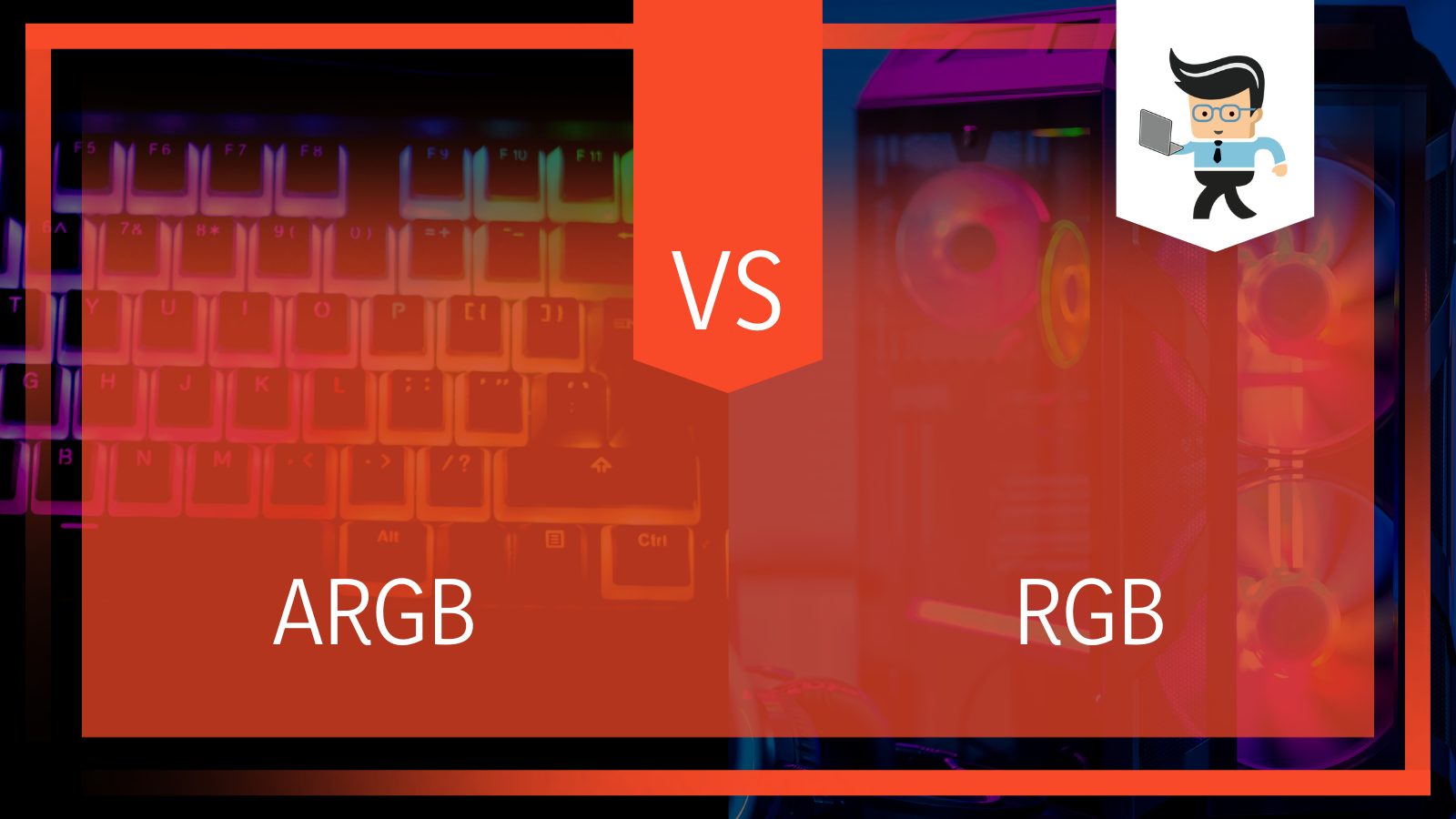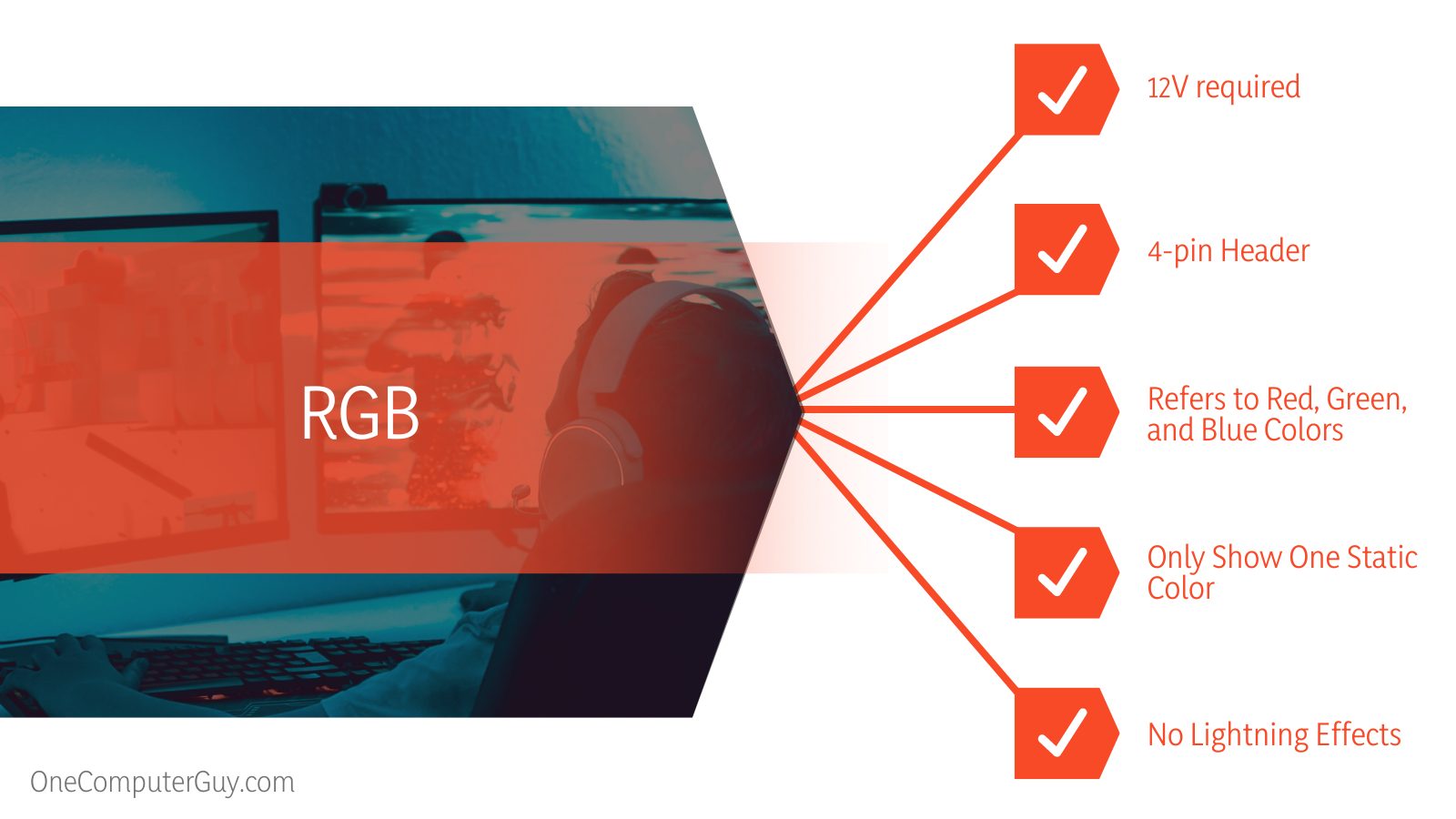ARGB vs RGB is a very common topic of discussion among gamers, and if you’re also not clear about the differences between the two and which one is better, we’re here to clear out your confusion. Both are lighting options that allow customizability, but there are noticeable differences between the two.

Here’s what you need to know.
Contents
Comparison Table
| Features | ARGB | RGB |
| Voltage required | 5V | 12V |
| Pin header | 3-pin | 4-pin |
| Individual programmability | Yes | No |
| Lightning effects | Yes | No |
| Price | More expensive | Less expensive |
What Are the Differences Between ARGB and RGB?
The main difference between ARGB and RGB is that the former is more customizable.
This is because you can change the intensity and color of individual lights in the ARGB strip, while all lights in the RGB will have the same intensity and color.
Main Differences Comparison
Adding color to your gaming setup can really take things up a notch. For instance, you can set your keyboard to light up red when you take some damage or green when you complete a mission successfully.
The two also have different headers. An ARGB header usually uses three pins for the connection (one stays empty) while the RGB header has four pins.
You can find a number of ARGB motherboards on the market today from big names like Gigabyte, Asus, and MSI.
Another difference lies in the amount of power they draw. ARGB uses 5V, while RGB uses 12V. This means that if you plug ARGB into an RGB motherboard, you will end up burning it.
But should you go for RGB or ARGB?
Let’s understand both technologies to figure that out.
– Explaining RGB Specifications
RGB refers to red, green, and blue colors and is also referred to as multicolor. It is used for lighting purposes in different electronic devices, ranging from monitors and smartphones to TVs and tablets.
Red, green, and blue are primary colors and can be combined to form virtually any color you can think of within the color space by adjusting each color’s intensity.
RGB lights can only show one static color. In other words, all the lights in your RGB lighting strip will have the same color.
This allows gamers to match their systems to their favorite characters or games or create aesthetically-pleasing lighting in their PC case.
RGB LEDs are available in a number of sizes and shapes and range from individual diodes to clusters commonly used in PC cases.
– Explaining ARGB Specifications
ARGB or addressable RGB provides more control over your lighting and color space and allows you to change the LED light at an individual level.

This means you can control the colors of single lights and further customize them by setting them to cycle through different colors across the spectrum, synchronize with the music playing, etc.
This also means that, unlike RGB, ARGB lights can show different colors at the same time and can be manipulated using an ARGB controller or software to show a complete range of colors at any time.
ARGB lights come with an IC or integrated circuit inside that you use to control the pattern, tempo, and color of the lights.
So you can not only change the color, but you can also set different lighting effects like changing periodically, blinking, blipping, etc.
You also have full customizability over color dynamics, so you can try unique colors until you find a combination that defines you as a gamer.
You can also do a bunch of other cool stuff, like set the light to change according to the beat of the song playing on your speaker.
ARGB and RGB Affect on Performance
Your system’s performance and the lighting technologies have no correlation. In other words, neither RGB nor ARGB affects performance at all.
Motherboards only give the light strips the power they require to light up, whether they’re RGB or ARGB.
There’s no processing or computing involved, which is why the lights have no impact on the performance.
When your system doesn’t perform as you expect it to, it is usually because the graphics card or processor has to spend a little time to send the necessary instructions to it.
Since ARGB and RGB devices plug in directly to the motherboard or through an adapter, they don’t interfere with the processor or graphics card.
Some ARGB and RGB devices use drivers and run as a process on your PC. These do use some processing power, but it’s so insignificant that it’s barely noticeable.
The only time it would make any difference is when something is wrong with the program that handles ARGB or RGB lighting has a big bug. But that is quite rare.
What Is ARGB Best For?
ARGB is the best option for setting specific colors down to the pixel level. Typically, ARGB is used in laptop and PC displays but generally, if you want more precise control over the colors than you get from RGB, then you should definitely look into this mode.
– Advantages and Uses
However, keep in mind that it needs more processing power to function, which means all ARGB components draw more power and are relatively hotter. ARGB also typically costs more than RGB because of the added complexity. So if you have a bigger budget, you can go ahead and choose ARGB.
ARGB is also the right option if you think that your PC or laptop isn’t as flashy as you’d like it to be. Since it’s now available on a variety of devices, you can turn to ARGB products to take your setup up a notch.
What Is RGB Best For?
RGB is more common out of the two lighting options and is a better option if you’re looking for something low-cost to customize how your headphones, mouse, keyboard, display, or other components look.

Of course, you can use ARGB on RGB components too, but the latter provides more options.
– Advantages and Uses
Like ARGB, RGB also has an initial cost, but it’s relatively less, even though the price gap between the two is really not that much now.
And not to mention, RGB doesn’t require as much power as ARGB, so it runs relatively cooler and tends to draw less power.
So, if you’re short on budget, RGB is the better option.
FAQ
– Can I Use ARGB in an RGB Motherboard?
RGB is old technology, which means older motherboards will either have an RGB header or connector or no connector at all.
So you won’t be able to connect ARGB directly to the motherboard; you will have to use some other connection method like SATA. Along with that, you’ll need a separate controller to control the lights.
Since replacing the motherboard just for ARGB can be quite expensive, the only option you can try out is an RGB to ARGB adapter.
– Is it Possible to Plug in ARGB into RGB Headers?
It is not possible to plug in your ARGB into RGB headers, and you shouldn’t even try. ARGB features three pins in its header, while RGB has four.
Trying to connect the two will only ruin the header and even the LED.
The cable for both is also different. ARGB cables usually have three threads, while RGB cables have four threads.
If your motherboard doesn’t have an ARGB header, and you want to add ARGB accessories, you can just purchase a standalone controller for those components.
– What Is ARGB Fan?
ARGB fans are just fans that can adjust all the lights inside it separately, giving you a wide range of colors.
To be able to use them, you need an ARGB-capable motherboard or controller to control the color, intensity, and effects of the light.
– Jrgb vs ARGB – What’s the Difference?
The two terms are quite similar, making it easy to understand why they can be confusing.
But essentially, ARGB is the lighting technology that you use to control everything related to the light.
Meanwhile, JRGB is the name of the 12V header on the MSI motherboard. But keep in mind that you shouldn’t connect ARGB fans to this JRGB since it is only meant for RGB fans.
For this fan, you will need to connect it to a 5V header, which is known as jrainbow on the MSI motherboard.
– What Devices Feature RGB or ARGB?
Take a look at your computer and start listing off all the components you can see.
Each component can be RGB or ARGB, including the mouse, the case, LED strips, RAM sticks, fans, speakers, graphics card, keyboard, motherboard, and so on.
But one of the most popular RGB/ARGB components is a keyboard, and understandably so – it makes your boring keyboard more interesting by letting your controller choose the lights depending on your task.
For instance, you can set your lights to behave differently depending on your activities in the same game.
An RGB and ARGB-lit mouse also works the same way. Some people love muted quiet lighting. If you’re also one of those, you can stick to having static lighting.
Conclusion
The answer to the ARGB vs RGB debate is quite simple – ARGB is essentially a more advanced and better version of RGB.
So let’s quickly summarize the differences once again:
- The biggest difference is that with ARGB, you get to have control over individual lights, which means you can show a multitude of colors across your light strip.
Meanwhile, RGB provides singular capabilities only, which means you can show only a single color at a time.
- ARGB products can take your PC experience up a notch by allowing you to add additional lighting effects for music and games, like setting the light to change according to the beat of your music.
- The headers and power requirements for the two are also different. ARGB needs a 5V header with three pins, while RGB needs a 12V header with four pins.
This also means you cannot interchange the headers; you can connect ARGB only with its dedicated header.
- ARGB and RGB are available for nearly all components you can connect to your system, including speakers, keyboard, mouse, fans, motherboard, etc.
It’s clear that ARGB is the more modern option. So if you’re looking to spruce up your computer or are building one from scratch and want to add lighting, it’s better if you choose ARGB instead of RGB.







